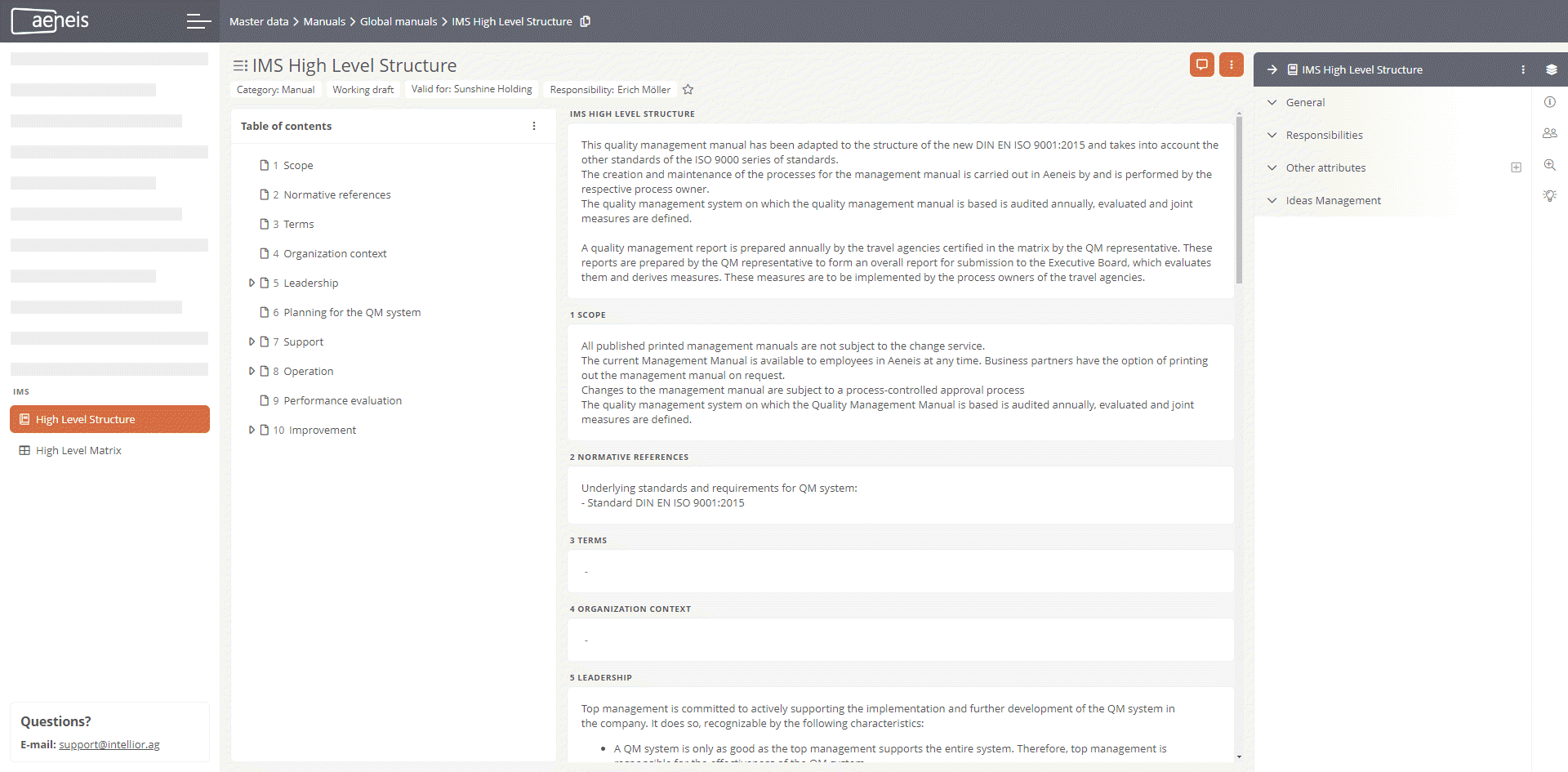IMS (Integrated Management System)
By default, the Portal has a process-oriented IMS (Integrated Management System), in which you can harmonize the manuals for your organization's management systems. The aim of the IMS is to fulfill the standard requirements of the individual management systems according to a uniform scheme and thus eliminate multiple efforts, e.g. in the case of audits.
Note: By default, only users in the groups UsersManagers and Administrators can see this area.
Tip: To use the IMS effectively, we recommend the additional use of our Apps for management systems.
With the IMS in Aeneis, you can combine the following management systems, for example, taking into account the applicable standards:
-
Quality management according to ISO 9001
-
Occupational health and safety in accordance with ISO 45001
-
Environmental management according to 14001
-
Compliance according to ISO 37301
-
Information security according to ISO 27001
-
Crisis or emergency management according ISO 22301
-
Risk management according to ISO 31000
-
etc.
Example: You can also include industry-specific standards in your IMS, such as IATF 16949 (automotive industry) or EN/AS 9100 (aviation).
To illustrate how your organization meets the normative requirements for its management systems and applies IMS-relevant standards, the following areas are available to you in the Portal navigation under BPM Reports:
IMS High Level Structure
The IMS High Level Structure (HLS) in Aeneis is the management manual in which you describe how you fulfill the requirements that standards place on your management systems:
The structure of the HLS is specified by the International Organization for Standardization (ISO). You can use this standardized basic structure in Aeneis for all management systems:
-
Introduction
-
Scope
-
Normative references
-
Terms and definitions
-
Organization context
-
Leadership
-
Planning
-
Support
-
Operation
-
Performance evaluation
-
Improvement
Note: The labels and number of sub-chapters defined in the individual standards differ depending on the subject area. The chapter structure should be adapted according to the normative requirements of the management systems.
The HLS at Aeneis is a SmartDoc. This means you can adapt the structure of the manual to the standard requirements of your management systems. You can also use SmartEdit to create and edit the content of the individual manual chapters.
Example: Describe in your HLS how you meet the requirements for quality management in accordance with ISO 9001, energy management in accordance with ISO 50001 and information security management in accordance with ISO 27001.
Tip: You can use the properties area to customize and add information to individual chapters. If your IMS also relates to compliance, for example, adjust the standard designation of Chapter 6 Planning for the QM system accordingly.
In addition, users can get involved in the HLS improvement process by submitting a proposal or creating an initiative.
Note: In processes, you can use the High Level Structure Link property to link the HLS to the respective process.
High Level Matrix
In the High Level Matrix area, you can get an overview of the organization areas in which the standard requirements of your management systems are or have been implemented. In the High Level Matrix, you can see all the standard chapters that are stored in Aeneis in a table:
Note: Standard chapters on ISO 9001, ISO 27001, ISO 45001, ISO 14001, ISO 50001, VDA 6.3 and IATF 16949 are stored in the Aeneis delivery state.
Note: In the delivery state, standard chapters are displayed without content. If relevant for you, add the content in the respective standard chapter in the Description attribute or in the corresponding SmartDoc for the standard.
Tip: Remove standards chapters that you do not need from the master data and create standards chapters that are relevant for your IMS.
The objects related to the respective standard chapter are displayed for each standard chapter. In the delivery state, these are the following objects:
-
Processes that relate to the standard chapter
-
Documents in which the standard chapter is implemented
-
Organizational units in which the standard chapter is implemented
-
Roles responsible for implementing the standard chapter
-
Audits in which the standard chapter was reviewed
Note: You can use the Columns property in the properties of the High Level Matrix to configure which objects are displayed in the table if there is a reference to the respective standard chapter.


